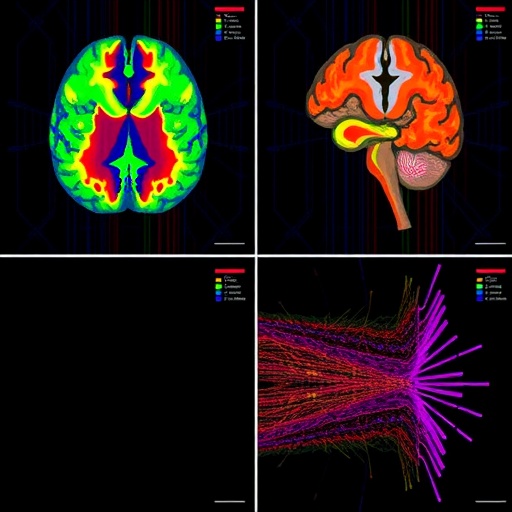In the latest breakthrough study published in Translational Psychiatry, researchers have unveiled compelling insights into the neural abnormalities linked to auditory verbal hallucinations (AVH) in individuals experiencing their first episode of schizophrenia. This pioneering investigation meticulously maps the abnormal cortical topographic patterns that underpin these hallucinations, offering a new window into the pathophysiology of schizophrenia with profound implications for future diagnostic and therapeutic strategies.
Auditory verbal hallucinations—perceptions of hearing voices without external stimuli—are among the most debilitating and enigmatic symptoms of schizophrenia. Despite decades of research, the precise neural mechanisms giving rise to these experiences have remained stubbornly elusive. The current study bridges this critical knowledge gap by employing advanced neuroimaging techniques combined with sophisticated topographic analytical methods to dissect brain activity patterns specific to AVH in first-episode patients.
Central to the study is the concept of cortical topography—the spatial organization of neuronal activity across the brain’s surface. In healthy individuals, this topographic arrangement underlies coherent perception and cognition. The investigators hypothesized that disruptions in this finely tuned cortical landscape could explain the spontaneous generation of hallucinatory voices characteristic of schizophrenia’s early phases.
Using data from a cohort of first-episode schizophrenia patients experiencing AVH, the researchers applied high-resolution functional magnetic resonance imaging (fMRI) alongside electroencephalography (EEG) to capture dynamic neural activity patterns. This multimodal approach allowed unprecedented resolution in identifying aberrations across auditory and language-processing networks. The results demonstrated marked alterations in the topographic brain maps within regions traditionally implicated in speech perception and production, notably the superior temporal gyrus and the inferior frontal gyrus.
Intriguingly, these aberrant cortical maps exhibited a distinctive signature differentiating hallucinators from non-hallucinating schizophrenia patients. This suggests that AVH is not merely a byproduct of general disease pathology but arises from discrete topographic dysfunctions that disrupt the brain’s ability to distinguish internally generated speech from external auditory input. The findings align with contemporary models proposing that hallucinations stem from impaired self-monitoring and misattribution of inner speech.
Further examination revealed that these abnormal topographic patterns correlated strongly with hallucination severity, implying that the extent of cortical disruption directly influences clinical presentation. Such correlations pave the way for developing objective neurobiological markers that could quantify symptom burden, monitor disease progression, and personalize treatment efficacy in real time.
Moreover, the study delved into the connectivity alterations accompanying these topographic changes. By scrutinizing the functional coupling between cortical regions, the researchers identified dysregulated network interactions particularly between language areas and default mode network regions implicated in self-referential processing. This network dysconnectivity likely exacerbates the generation and maintenance of hallucinatory experiences by fostering aberrant internal focus and impaired reality-testing mechanisms.
This groundbreaking research importantly extends beyond descriptive neuroimaging findings by integrating sophisticated computational modeling to simulate how disruptions in cortical topography might precipitate hallucinations. These models offer mechanistic explanations for the emergence of phantom auditory percepts, facilitating a more nuanced understanding of schizophrenia’s complex symptomatology.
Clinically, these insights hold transformative potential. By characterizing distinct neural fingerprints of AVH, clinicians could deploy personalized neurofeedback or targeted neuromodulation interventions such as transcranial magnetic stimulation (TMS) with refined precision. Therapeutic strategies aiming to recalibrate aberrant cortical maps might substantially alleviate hallucinatory symptoms, improving patient quality of life and functional outcomes.
From a translational research perspective, defining robust cortical topographic biomarkers could revolutionize early diagnosis and intervention. Currently, schizophrenia diagnosis relies predominantly on behavioral assessments, often after symptom onset has significantly impacted brain function. Objective neural indicators detected before full-blown symptoms develop would enable preventative care and mitigate disease burden.
The study also raises intriguing questions about the developmental origins of these cortical abnormalities. Longitudinal follow-ups could illuminate whether abnormal topographic patterns predate psychosis onset, potentially serving as early vulnerability markers in high-risk individuals. Understanding such trajectories may inform neurodevelopmental models of schizophrenia and guide interventions across the lifespan.
Furthermore, this research illuminates broader neurobiological principles beyond schizophrenia, addressing fundamental mechanisms by which the brain generates perceptual experience. By elucidating how cortical topography contributes to reality monitoring, these findings can impact theories within cognitive neuroscience regarding consciousness and sensory integration.
The methodological rigor exemplified by combining fMRI, EEG, and computational neuroscience sets a new standard for schizophrenia research. This multimodal paradigm captures both spatial and temporal dimensions of brain dysfunction, encapsulating the complexity of hallucinations more comprehensively than previous mono-modal studies. Consequently, it charts a promising roadmap for future investigations into psychiatric and neurological disorders featuring sensory misperceptions.
Ultimately, Gao, Sun, Zhu, and colleagues’ landmark study provides a critical leap forward in deciphering schizophrenia’s enigmatic symptoms. Through meticulous charting of cortical topographic aberrations linked to auditory hallucinations, it not only deepens scientific understanding but also ignites hope for innovative diagnostic tools and precision therapeutics. As schizophrenia remains a leading cause of disability worldwide, such advances are urgently needed to improve patient care and societal outcomes.
As research accelerates in this frontier field, collaborative efforts integrating neuroimaging, computational modeling, genetics, and clinical trials stand to unravel further mysteries surrounding schizophrenia and hallucinations. This integrative approach promises to transform psychiatric medicine by unveiling mechanistic paths from brain circuitry anomalies to complex behavioral phenotypes. The future of mental health treatment may ultimately hinge on unraveling these intricate neural maps with ever-increasing resolution.
In summary, the study’s identification and characterization of abnormal cortical topographic patterns associated with auditory verbal hallucinations represent a monumental stride toward resolving the neural substrates of schizophrenia. Bridging phenomenology with neurobiology, this work charts exciting courses for enhanced understanding, diagnosis, and targeted intervention—heralding a new era in the neuroscience of mental illness.
Subject of Research: Neural correlates of auditory verbal hallucinations in first-episode schizophrenia focusing on abnormal cortical topographic patterns.
Article Title: Abnormal cortical topographic patterns associated with auditory verbal hallucination in first-episode schizophrenia.
Article References:
Gao, Z., Sun, H., Zhu, F. et al. Abnormal cortical topographic patterns associated with auditory verbal hallucination in first-episode schizophrenia. Transl Psychiatry (2025). https://doi.org/10.1038/s41398-025-03748-y
Image Credits: AI Generated
DOI: https://doi.org/10.1038/s41398-025-03748-y




